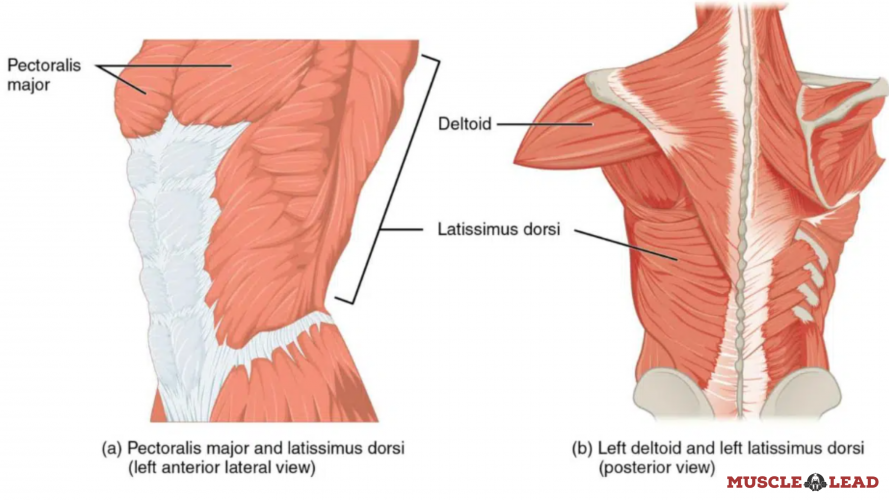Strong lats could make your barbell deadlift safer and more effective than EVER!
Do deadlifts work the lats? Yes, the lats get engaged during the deadlifts. However, don’t expect much growth and strength of the lats from deadlifts alone. When you learn how to engage the lats in the deadlift it stabilizes your shoulders and upper back. This allows you to keep the bar close and pull with a neutral spine. Include other vertical and horizontal lifts to strengthen your lats.
If you know how to engage the lats in the deadlift, you will be able to maneuver the bar to apply the energy onto the muscles. Secondly, you will be able to stabilize the spine for optimal safety.
You are not sure if your lats are strong enough? Well, there are certain indicators that highlight weak lats. If you have figured out that you are not quite there yet, we know of a few ways to strengthen the lats and reap the deadlift benefits.
Continue reading to find out the role of the lats during deadlifts. We also discuss ways to engage your lats in deadlifts.
What are the Lat Muscles?
Do you see that winged shape muscle of the outer back? Those are the lats, short for latissimus dorsi. (1)

There are two of them and they connect from the back of the ribs to the upper arm bone.
The movement of the upper lat is the adduction of the upper arm. This movement may be better understood by saying bringing the upper arm into the body from the side.
I am sure you have seen the lat pulldown machine.
The middle and lower lats are activated by either horizontal or vertical extension of the upper arm.
You will come to learn the relevance of these movements for the deadlift in the next section.
Do Deadlifts Work the Lats?
You may not have thought about this, but the lats have multiple roles in the deadlift. I have included 3 below. (2)
1. Help Complete the Deadlift
This might come as a surprise. Deadlift grip width changes the part of the lat that is activated.
Shoulder Width Grip Deadlift
The lower lats are connected into the back in such a way that they are activated by vertical extension of the upper arm.
This basically means pulling the upper arm downwards and close to the body.
While finishing off the upward phase of the deadlift we tend to pull the arm backwards in this manner.
Therefore, along with other back and shoulder muscles, the lower lats also come into play more.
How to Maximize Your Deadlift Grip: Never Fail Again
Wide Grip Deadlift
As you know, the middle portion of the lats is brought into action by the horizontal extension of the upper arm.
Some lifters opt for a very wide grip for deadlift. Kind of snatch-esc. Due to the nature of the arm position, the middle part of the lat would be targeted more.
2. Support Bar Path
We know that the lats help bring the arm back either vertically or horizontally. For this reason, they can limit the amount the bar drifts away while deadlifting.
This makes the lift so much more safer and energy efficient.
Allowing the bar to drift away demands for range to complete the lift. Secondly, this type of positioning risks a muscle strain or tear.
3. Contribute Towards Spinal Neutrality
Deadlifting with the straight bar poses spinal injury risk. As the weight is lifting from the front of the body, the spine can curve forwards.
Along with the core stability muscles, the lats play a role in stabilizing the spine.
Think About it, the lats flare backwards when braced. This engagement stops the spine from curving forward.
4 Indicators that Highlight Weak Lats During the Deadlift
At times we mess up on a lift, but do not always know what was the weak link. During the deadlift weak lats tend to flag up. (2)
We have covered 4 indicators of weak lats.
1. Inability to Finish the Deadlift
At times lifters are not able to pull the arms back to complete the rep. There is a chance that the lats are not strong enough in this position.
Although there could be other muscles that are not playing their part. The traps and rear deltoids (shoulders) help pin back the shoulder blades and pull back the arm to complete a deadlift.

2. Back Rolling Forwards
I could think of a few reasons why the spine curves forward. For example, weak or fatigued core stability muscles, muscle injury, poor deadlift form, etc.
One of the reasons could be weak lats. It can be difficult to tell. The best indicator based on my exercise is the lats flaring and wing forwards. Strong lats should be braced and tucked back.
3. Bar Drifting Away from the Body
The bar can also drift forward for many reasons. If the lats are weak they will not be able to keep a straight bar path. An indicator we could look out for is the bar drifting with winged and flared lats.
4. Skeletal Injury
I have come across lifters who have pulled or torn a muscle while deadlifting. There is a possibility that the lat muscles were not strong enough to maintain a safe bar path. This results in overstretching a muscle, followed by straining or tearing.
4 Ways to Strengthen and Engage the Lats in Deadlifts
Not all is lost If you can relate to any of the 4 indicators mentioned. We have given 4 expert tips on how to strengthen the lats for deadlifts.
1. Work the Lats more Frequently
Some lifters ‘hide under the blanket’ if they are told that they could make some gains from hitting a muscle group more than once per week.
There seems to be an irrational fear of overtraining. I think it stems from gym bros taking research out of content and just chaining on false information.
Truth be told, there is nothing wrong with working a muscle group more than once per week, especially if it is genetically not your strong point.
Top 10 Lat Pulldown Alternatives (+How to Videos)
Training the lats more frequently will give them additional stimulus and lengthen muscle protein synthesis (muscle building). In turn, this can make them bigger and stronger in the longer term.
It entirely depends on the person, but we could be looking at 2-6 extra lat work per week. Once you have stronger lats, it can translate into a stronger deadlift.
2. Work the Lats at Higher Intensities
Based on what we know about strength training, a muscle group has more potential to get stronger when you go hard and heavy. Of course, this will vary from person to person.
So a lifter could train within 80-100% of their 1RM giving them 1-5 reps per exercise set.
For example, let’s say that a lifter with 80% close grip lat pulldown strength sits around 175 pounds. This may hit 5 reps before the lifter begins to tire out.
3. Use Specific Deadlift Variations
If you think about lat engagement of the deadlift, it comes about during the final part of pulling the arms backwards.
If we find a deadlift variant that focuses solely on this movement, we could strengthen the lat movement pattern of the deadlift.
Best Deadlift Accessory Exercises to Get Stronger
Do you know of any exercises that work this motion? Not to worry if you do not, because we have your back! We are typically looking at exercises like block pulls and rack pulls.
4. Deadlift more Frequently
I am a firm believer that to make a lift stronger, we must focus on that lift itself. We could do all the rack pulls we want to get the full movement pattern going. We must use the deadlift.
This is not to say that you would neglect the other mentioned methods. Ideally, you or a qualified professional could put together a program that focuses on the lat strength, if needed.
Can You Deadlift Everyday? Let’s Discuss the Pros and Cons
Final Thoughts
We now know that the lats are large wing shaped muscles on the outer part of the back.
Do deadlifts work the lats? The lats help maneuver and complete the movement. They also help keep the spine in a safe position.
If you suspect weak lats, there are a few telltale signs to look out for. These include; not being able to complete the final movement of the lift, spine rolling forwards, bar drifting forwards or injury.
Nevertheless, we can always strengthen and learn how to engage the lats in deadlifts. To do so, you can work them more frequently, and at higher intensities.
Other ways to strengthen them would be to use exercises that target the lat specific movements of the lift. Last but not least, doing the actual deadlift to perfect the movement as a whole.
FAQs
Yes! You could build the lower and middle part of the lats with the deadlift.
Absolutely! The deadlift engages the lats, so you may feel them working.
Yes! Not just the lats, but the traps to fq¹1rom all of the shoulder blade movements.
Most definitely! It is not of the ordinary, if the morning after deadlifts you wake up with lat soreness.
References
- Jenny, S.H., &., Varacallo, M. ‘Anatomy, Back, Latissimus Dorsi’ StatPearls. 2022; [Internet]
- Diamant, W., Geigster, S., Havers, T., et al. ‘Comparison of EMG Activity between Single-Leg Deadlift and Conventional Bilateral Deadlift in Trained Amateur Athletes – An Empirical Analysis’ International Journal Of Exercise Science. 2021; 14(1): 187–201
More on Deadlifts:





